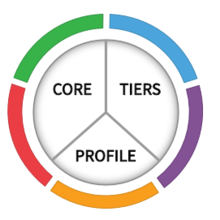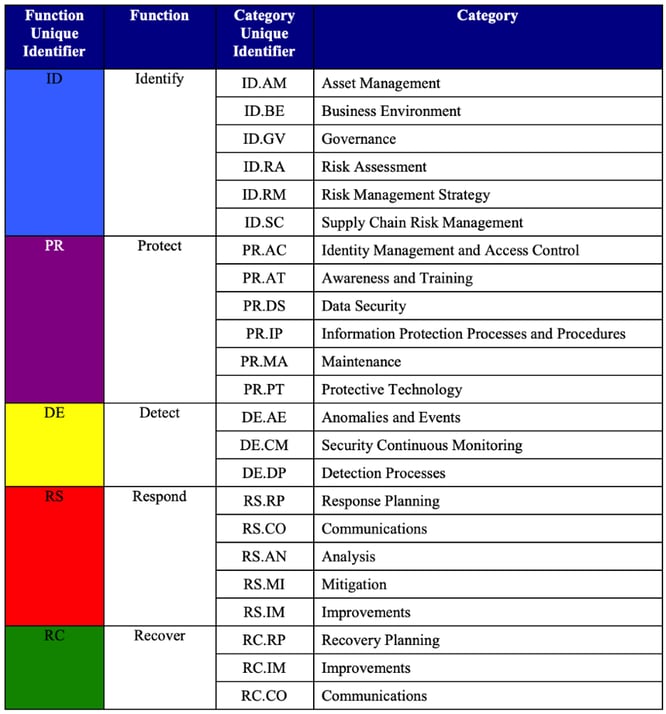Introduction to the NIST Cybersecurity Framework
Published 04/21/2021
 This blog was originally published by OpsCompass here
This blog was originally published by OpsCompass here
Written by Kevin Hakanson, OpsCompass
Security Framework Based on Standards, Guidelines, and Practices
The NIST Cybersecurity Framework (NIST CSF) was created via a collaboration between the United States government and industry as a voluntary framework to promote the protection of critical infrastructure, and is based on existing standards, guidelines, and practices. The NIST CSF consists of three main components: Core, Implementation Tiers, and Profiles. In this blog, we will explore the Framework Core with the same example we used in Understanding CIS Controls and Benchmarks.

Source: NIST Cybersecurity Framework
The Framework Core provides a “set of activities to achieve specific cybersecurity outcomes, and references examples of guidance to achieve those outcomes” and is separated into five high level Functions (Identify, Protect, Detect, Respond, Recover). Each function is further divided to 23 Categories (see figure below), each of which are assigned an identifier (ID) and are closely tied to needs and activities. The deepest level of abstraction in the NIST CSF are the supporting 108 Subcategories, which are associated with multiple Informative References linking back to other standards, guidance, and publications including the CIS Controls (CIS CSC). As with many frameworks, consider the details as illustrative and risk informing and not as exhaustive listing.
As described in section 2.1 of the (NIST) Framework for Improving Critical Infrastructure Cybersecurity Version 1.1 Update:
- Identify (ID) – Develop an organizational understanding to manage cybersecurity risk to systems, people, assets, data, and capabilities.
- Protect (PR) – Develop and implement appropriate safeguards to ensure delivery of critical services.
- Detect (DE) – Develop and implement appropriate activities to identify the occurrence of a cybersecurity event.
- Respond (RS) – Develop and implement appropriate activities to take action regarding a detected cybersecurity incident.
- Recover (RC) – Develop and implement appropriate activities to maintain plans for resilience and to restore any capabilities or services that were impaired due to a cybersecurity incident.

Source: Table 1, Framework for Improving Critical Infrastructure Cybersecurity Version 1.1
To continue with the Multi-Factor Authentication (MFA) example from our previous CIS Controls and Benchmarks post, let’s drill into the Protect (PR) Function and look at the PR.AC Category described by NIST as:
Identity Management, Authentication and Access Control (PR.AC): Access to physical and logical assets and associated facilities is limited to authorized users, processes, and devices, and is managed consistent with the assessed risk of unauthorized access to authorized activities and transactions.
This clearly pertains to the identity of users and how they authenticate into systems. Going further down into the PR.AC-7 subcategory:
PR.AC-7: Users, devices, and other assets are authenticated (e.g., single-factor, multi-factor) commensurate with the risk of the transaction (e.g., individuals’ security and privacy risks and other organizational risks)
Additionally, the Informative References for PR.AC-7 include a reference to CIS CSC 1, 12, 15, 16. That list contains CIS Control 16,which is Account Monitoring and Control and includes subcontrol 16.3 Require Multi-factor Authentication. However, PR.AC-7 doesn’t seem to mention CIS Control 4: Controlled Use of Administrative Privileges and subcontrol 4.5: Use Multi-Factor Authentication for All Administrative Access.
Combining NIST CSF together with the CIS Controls, a user with admin access requires MFA according to this set of recommendations.
- CIS Controls v7.1 4.5
- CIS Controls v7.1 16.3
- NIST CSF v1.1 PR.AC-7
Unlock Cloud Security Insights
Subscribe to our newsletter for the latest expert trends and updates
Related Articles:
AAGATE: A NIST AI RMF-Aligned Governance Platform for Agentic AI
Published: 12/22/2025
Is Cloud-Native Key Management Right for You?
Published: 12/19/2025
Enhancing the Agentic AI Security Scoping Matrix: A Multi-Dimensional Approach
Published: 12/16/2025


.png)
.jpeg)
.jpeg)
.jpeg)
.jpeg)